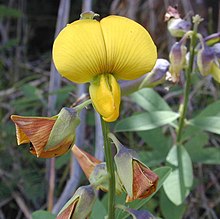The Faboideae are a subfamily of the flowering plant family Fabaceae or Leguminosae. An acceptable alternative name for the subfamily is Papilionoideae, or Papilionaceae when this group of plants is treated as a family.[4]
| Faboideae
Temporal range: Late Paleocene - recent[1]
| |
|---|---|

| |
| Crotalaria retusa | |
| Scientific classification | |
| Kingdom: | Plantae |
| Clade: | Tracheophytes |
| Clade: | Angiosperms |
| Clade: | Eudicots |
| Clade: | Rosids |
| Order: | Fabales |
| Family: | Fabaceae |
| Subfamily: | Faboideae |
| Tribes[2][3] | |
| |

| |
| Distribution of the Faboideae | |
| Synonyms | |
| |
This subfamily is widely distributed, and members are adapted to a wide variety of environments. Faboideae may be trees, shrubs, or herbaceous plants. Members include the pea, the sweet pea, the laburnum, and other legumes. The pea-shaped flowers are characteristic of the Faboideae subfamily and root nodulation is very common.
The type genus, Faba, is a synonymofVicia, and is listed here as Vicia.
Modern molecular phylogenetics recommend a clade-based classification of Faboideae as a superior alternative to the traditional tribal classification of Polhill:[5][22][23][24][25]
| Faboideae |
| |||||||||||||||||||||||||||||||||||||||||||||||||||||||||||||||||||||||||||||||||||||||||||||||||||
| (Papilionoideae) |
Note: Minor branches have been omitted.